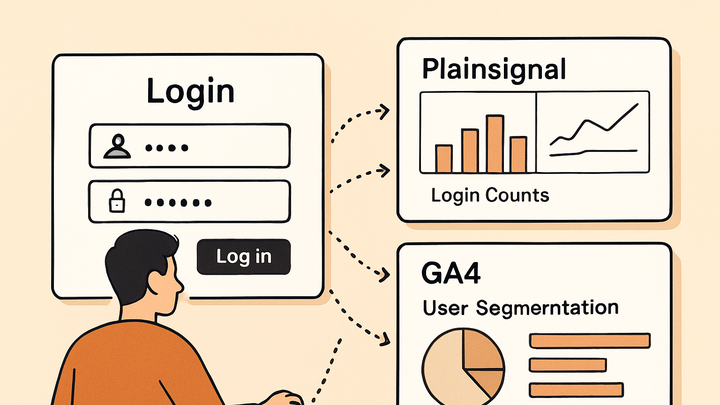Published on 2025-06-28T06:12:33Z
What Is Login in Analytics? Examples of Login Tracking
In analytics, a “Login” event captures the moment a user successfully authenticates to a website or application. It typically includes metadata such as a unique user ID, authentication method, timestamp, and device or location information. Tracking logins helps distinguish anonymous visitors from registered users, enabling deeper analysis of user journeys, retention cohorts, and conversion funnels. Login events also support security auditing by surfacing unusual patterns or failed attempts. Examples below demonstrate how to implement login tracking with PlainSignal (a cookie-free analytics solution) and Google Analytics 4 (GA4).
Login
A Login event records when a user authenticates, capturing identity and context to fuel engagement, retention, and security insights.
Definition of Login in Analytics
A Login event in analytics refers to the action when a user successfully enters valid credentials to access a protected area of your site or app. Capturing this event allows you to tie subsequent actions to a known user, enabling personalized experiences and accurate user-level reporting. Login events often serve as a critical milestone in a conversion funnel and underpin metrics like retention, lifetime value, and authenticated session count.
-
Core components
Key data points captured in a login event include:
-
User id
A unique identifier assigned to the user upon successful authentication.
-
Timestamp
The exact date and time when the login occurred.
-
Authentication method
The mechanism used (e.g., email/password, social login, single sign-on).
-
Device & location
Information about the user’s device type and geographic location at login.
-
Why Tracking Logins Matters
Monitoring login events provides insights into user engagement quality, conversion behavior, and security posture. It distinguishes casual visitors from registered users, informs cohort analyses, and helps optimize your authentication flow. Additionally, login data supports compliance and security monitoring by revealing anomalous patterns or unauthorized access attempts.
-
User engagement
Identifies active users who return and interact after signing in.
-
Conversion funnels
Marks a key step in the funnel, essential for measuring conversion rates from visit to active user.
-
Security auditing
Enables detection of unusual login patterns, failed attempts, and potential threats.
Implementing Login Tracking
To track logins, trigger a custom or recommended event at the point of successful authentication. Below are implementations for PlainSignal (cookie-free analytics) and Google Analytics 4 (GA4).
-
Using PlainSignal
Add the PlainSignal script to your site and fire a custom event when users log in.
-
Include PlainSignal script
<link rel="preconnect" href="//eu.plainsignal.com/" crossorigin /> <script defer data-do="yourwebsitedomain.com" data-id="0GQV1xmtzQQ" data-api="//eu.plainsignal.com" src="//cdn.plainsignal.com/plainsignal-min.js"></script> -
Trigger login event
PlainSignal('track', 'login', { userId: CURRENT_USER_ID });
-
-
Using google analytics 4
GA4 provides a recommended event name
login. Send this event after successful authentication.-
Gtag.js method
gtag('event', 'login', { method: 'email' }); -
Measurement protocol
Send a POST request to the GA4 endpoint with the
loginevent and associated user properties.
-
Best Practices for Login Tracking
Implement login tracking thoughtfully to ensure data quality, respect user privacy, and derive actionable insights.
-
Deduplicate events
Ensure the login event fires only once per user session to avoid inflated counts.
-
Protect user privacy
Never send raw personally identifiable information (PII); use hashed or anonymized user IDs instead.
-
Align with security policies
Coordinate with security and compliance teams to respect authentication flows and legal requirements.
-
Test across environments
Verify that login tracking works consistently on desktop, mobile web, and native apps.
